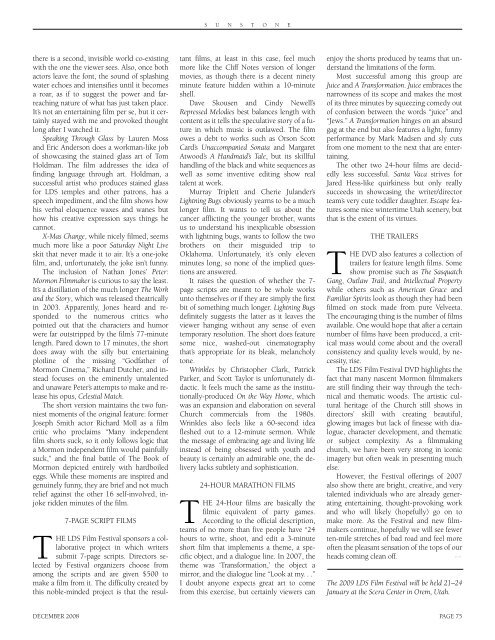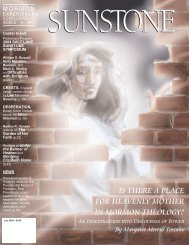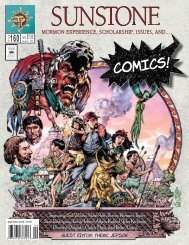Download Entire Issue PDF - Sunstone Magazine
Download Entire Issue PDF - Sunstone Magazine
Download Entire Issue PDF - Sunstone Magazine
Create successful ePaper yourself
Turn your PDF publications into a flip-book with our unique Google optimized e-Paper software.
S U N S T O N E<br />
there is a second, invisible world co-existing<br />
with the one the viewer sees. Also, once both<br />
actors leave the font, the sound of splashing<br />
water echoes and intensifies until it becomes<br />
a roar, as if to suggest the power and farreaching<br />
nature of what has just taken place.<br />
It’s not an entertaining film per se, but it certainly<br />
stayed with me and provoked thought<br />
long after I watched it.<br />
Speaking Through Glass by Lauren Moss<br />
and Eric Anderson does a workman-like job<br />
of showcasing the stained glass art of Tom<br />
Holdman. The film addresses the idea of<br />
finding language through art. Holdman, a<br />
successful artist who produces stained glass<br />
for LDS temples and other patrons, has a<br />
speech impediment, and the film shows how<br />
his verbal eloquence waxes and wanes but<br />
how his creative expression says things he<br />
cannot.<br />
X-Mas Change, while nicely filmed, seems<br />
much more like a poor Saturday Night Live<br />
skit that never made it to air. It’s a one-joke<br />
film, and, unfortunately, the joke isn’t funny.<br />
The inclusion of Nathan Jones’ Peter:<br />
Mormon Filmmaker is curious to say the least.<br />
It’s a distillation of the much longer The Work<br />
and the Story, which was released theatrically<br />
in 2003. Apparently, Jones heard and responded<br />
to the numerous critics who<br />
pointed out that the characters and humor<br />
were far outstripped by the film’s 77-minute<br />
length. Pared down to 17 minutes, the short<br />
does away with the silly but entertaining<br />
plotline of the missing “Godfather of<br />
Mormon Cinema,” Richard Dutcher, and instead<br />
focuses on the eminently untalented<br />
and unaware Peter’s attempts to make and release<br />
his opus, Celestial Match.<br />
The short version maintains the two funniest<br />
moments of the original feature: former<br />
Joseph Smith actor Richard Moll as a film<br />
critic who proclaims “Many independent<br />
film shorts suck, so it only follows logic that<br />
a Mormon independent film would painfully<br />
suck,” and the final battle of The Book of<br />
Mormon depicted entirely with hardboiled<br />
eggs. While these moments are inspired and<br />
genuinely funny, they are brief and not much<br />
relief against the other 16 self-involved, injoke<br />
ridden minutes of the film.<br />
7-PAGE SCRIPT FILMS<br />
THE LDS Film Festival sponsors a collaborative<br />
project in which writers<br />
submit 7-page scripts. Directors selected<br />
by Festival organizers choose from<br />
among the scripts and are given $500 to<br />
make a film from it. The difficulty created by<br />
this noble-minded project is that the resultant<br />
films, at least in this case, feel much<br />
more like the Cliff Notes version of longer<br />
movies, as though there is a decent ninety<br />
minute feature hidden within a 10-minute<br />
shell.<br />
Dave Skousen and Cindy Newell’s<br />
Repressed Melodies best balances length with<br />
content as it tells the speculative story of a future<br />
in which music is outlawed. The film<br />
owes a debt to works such as Orson Scott<br />
Card’s Unaccompanied Sonata and Margaret<br />
Atwood’s A Handmaid’s Tale, but its skillful<br />
handling of the black and white sequences as<br />
well as some inventive editing show real<br />
talent at work.<br />
Murray Triplett and Cherie Julander’s<br />
Lightning Bugs obviously yearns to be a much<br />
longer film. It wants to tell us about the<br />
cancer afflicting the younger brother, wants<br />
us to understand his inexplicable obsession<br />
with lightning bugs, wants to follow the two<br />
brothers on their misguided trip to<br />
Oklahoma. Unfortunately, it’s only eleven<br />
minutes long, so none of the implied questions<br />
are answered.<br />
It raises the question of whether the 7-<br />
page scripts are meant to be whole works<br />
unto themselves or if they are simply the first<br />
bit of something much longer. Lightning Bugs<br />
definitely suggests the latter as it leaves the<br />
viewer hanging without any sense of even<br />
temporary resolution. The short does feature<br />
some nice, washed-out cinematography<br />
that’s appropriate for its bleak, melancholy<br />
tone.<br />
Wrinkles by Christopher Clark, Patrick<br />
Parker, and Scott Taylor is unfortunately didactic.<br />
It feels much the same as the institutionally-produced<br />
On the Way Home, which<br />
was an expansion and elaboration on several<br />
Church commercials from the 1980s.<br />
Wrinkles also feels like a 60-second idea<br />
fleshed out to a 12-minute sermon. While<br />
the message of embracing age and living life<br />
instead of being obsessed with youth and<br />
beauty is certainly an admirable one, the delivery<br />
lacks subtlety and sophistication.<br />
24-HOUR MARATHON FILMS<br />
THE 24-Hour films are basically the<br />
filmic equivalent of party games.<br />
According to the official description,<br />
teams of no more than five people have “24<br />
hours to write, shoot, and edit a 3-minute<br />
short film that implements a theme, a specific<br />
object, and a dialogue line. In 2007, the<br />
theme was ‘Transformation,’ the object a<br />
mirror, and the dialogue line “Look at my. . .”<br />
I doubt anyone expects great art to come<br />
from this exercise, but certainly viewers can<br />
enjoy the shorts produced by teams that understand<br />
the limitations of the form.<br />
Most successful among this group are<br />
Juice and A Transformation. Juice embraces the<br />
narrowness of its scope and makes the most<br />
of its three minutes by squeezing comedy out<br />
of confusion between the words “juice” and<br />
“Jews.” A Transformation hinges on an absurd<br />
gag at the end but also features a light, funny<br />
performance by Mark Madsen and sly cuts<br />
from one moment to the next that are entertaining.<br />
The other two 24-hour films are decidedly<br />
less successful. Santa Vaca strives for<br />
Jared Hess-like quirkiness but only really<br />
succeeds in showcasing the writer/director<br />
team’s very cute toddler daughter. Escape features<br />
some nice wintertime Utah scenery, but<br />
that is the extent of its virtues.<br />
THE TRAILERS<br />
THE DVD also features a collection of<br />
trailers for feature length films. Some<br />
show promise such as The Sasquatch<br />
Gang, Outlaw Trail, and Intellectual Property<br />
while others such as American Grace and<br />
Familiar Spirits look as though they had been<br />
filmed on stock made from pure Velveeta.<br />
The encouraging thing is the number of films<br />
available. One would hope that after a certain<br />
number of films have been produced, a critical<br />
mass would come about and the overall<br />
consistency and quality levels would, by necessity,<br />
rise.<br />
The LDS Film Festival DVD highlights the<br />
fact that many nascent Mormon filmmakers<br />
are still finding their way through the technical<br />
and thematic woods. The artistic cultural<br />
heritage of the Church still shows in<br />
directors’ skill with creating beautiful,<br />
glowing images but lack of finesse with dialogue,<br />
character development, and thematic<br />
or subject complexity. As a filmmaking<br />
church, we have been very strong in iconic<br />
imagery but often weak in presenting much<br />
else.<br />
However, the Festival offerings of 2007<br />
also show there are bright, creative, and very<br />
talented individuals who are already generating<br />
entertaining, thought-provoking work<br />
and who will likely (hopefully) go on to<br />
make more. As the Festival and new filmmakers<br />
continue, hopefully we will see fewer<br />
ten-mile stretches of bad road and feel more<br />
often the pleasant sensation of the tops of our<br />
heads coming clean off.<br />
The 2009 LDS Film Festival will be held 21–24<br />
January at the Scera Center in Orem, Utah.<br />
DECEMBER 2008 PAGE 75

















